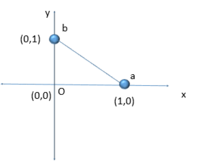MathsLearner
New member
- Joined
- Aug 13, 2017
- Messages
- 27
I am trying to solve the above problem. As per my thinking the diagram is some thing like this

the question says perpendicular to x - axis, there are two possibilities along the y-axis or along the z-axis, I think it is the z-axis. I am not sure how the solid looks like. Are there any on line tools to draw these diagrams?
My calculations are Area of the triangle is
[MATH] \frac 1 2 * 1 * 1 = 0.5 \\ V = \int A(x) dx [/MATH]I am not sure of the limits of the integral and the area in terms of x. Please help.
